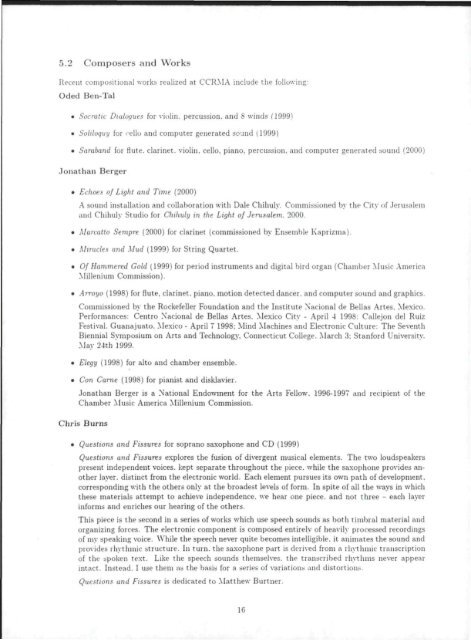Download - CCRMA - Stanford University
Download - CCRMA - Stanford University
Download - CCRMA - Stanford University
Create successful ePaper yourself
Turn your PDF publications into a flip-book with our unique Google optimized e-Paper software.
5.2 Composers and Works<br />
Recent compositional works realized at <strong>CCRMA</strong> include the following:<br />
Oded Ben-Tal<br />
• Socratic Dialogues for violin, percussion, and 8 winds (19991<br />
• Soliloquy for cello and computer generated sound (1999)<br />
• Saraband for flute, clarinet, violin, cello, piano, percussion, and computer generated sound (2000)<br />
Jonathan Berger<br />
• Echoes of Light and Time (2000)<br />
A sound installation and collaboration with Dale Chihuly. Commissioned by the City of Jerusalem<br />
and Chihuly Studio for Chihuly in the Light of Jerusalem. 2000.<br />
• Maivatto Sempre (2000) for clarinet (commissioned by Ensemble Kaprizma).<br />
• Mirucles and Mud (1999) for String Quartet.<br />
• Of Hammered Gold (1999) for period instruments and digital bird organ (Chamber Music America<br />
Millenium Commission).<br />
• Arroyo (1998) for flute, clarinet, piano, motion detected dancer, and computer sound and graphics.<br />
Commissioned by the Rockefeller Foundation and the Institute Nacional de Bellas Artes. Mexico.<br />
Performances: Centro Nacional de Bellas Artes. Mexico City - April 4 1998: Callejon del Ruiz<br />
Festival. Guanajuato. Mexico - April 7 1998: Mind Machines and Electronic Culture: The Seventh<br />
Biennial Symposium on Arts and Technology. Connecticut College. March 3: <strong>Stanford</strong> <strong>University</strong>.<br />
May 24th 1999.<br />
• Elegy (1998) for alto and chamber ensemble.<br />
• Con Carne (1998) for pianist and disklavier.<br />
Jonathan Berger is a National Endowment for the Arts Fellow. 1996-1997 and recipient of the<br />
Chamber Music America Millenium Commission.<br />
Chris Burns<br />
• Questions and Eissur-es for soprano saxophone and CD (1999)<br />
Questions and Eissures explores the fusion of divergent musical elements. The two loudspeakers<br />
present independent voices, kept separate throughout the piece, while the saxophone provides another<br />
layer, distinct from the electronic world. Each element pursues its own path of development,<br />
corresponding with the others only at the broadest levels of form. In spite of all the ways in which<br />
these materials attempt to achieve independence, we hear one piece, and not three - each layer<br />
informs and enriches our hearing of the others.<br />
This piece is the second in a series of works which use speech sounds as both timbral material and<br />
organizing forces. The electronic component is composed entirely of heavily processed recordings<br />
of my speaking voice. While the speech never quite becomes intelligible, it animates the sound and<br />
provides rhythmic structure. In turn, the saxophone part is derived from a rhythmic transcription<br />
of the spoken text. Like the speech sounds themselves, the transcribed rhythms never appear<br />
intact. Instead. I use them as the basis for a series of variations and distortion^.<br />
Questions and Eissures is dedicated to Matthew Burtner.<br />
16

















